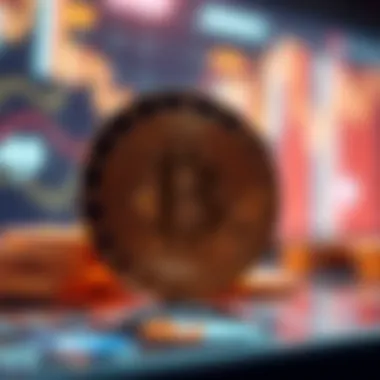Understanding Non-Fungible Tokens: A Comprehensive Overview


Intro
In the realm of digital assets, non-fungible tokens (NFTs) have emerged as prominent players, reshaping how we think about ownership and value. As distinct entities, NFTs represent ownership for a specific item, unlike cryptocurrencies such as Bitcoin, which are interchangeable. This unique characteristic sets the stage for their growing importance across various sectors from art to gaming.
Understanding Cryptocurrency Market Trends
Within the broader landscape of digital currencies, NFTs have carved out a niche of their own. By closely examining the underlying market trends, one can gain valuable insights into how these tokens adapt to the fluctuating dynamics of the cryptocurrency ecosystem.
Current Market Analysis
The NFT market has seen extraordinary growth over recent years. Marketplaces like OpenSea and Rarible have become bustling hubs for NFT transactions, attracting millions of users globally. Various reports have indicated that sales volume has skyrocketed, in some quarters surpassing traditional sectors like the fine art market. Wealthy investors are keenly eyeing the phenomenon, pushing the prices of certain collections into astonishing territories.
This surge is driven largely by a shift in how people perceive value in the digital age. For instance, digital artists can now monetize their work in ways that were previously unimaginable. Creators like Beeple have demonstrated this phenomenon, selling digital artwork for tens of millions of dollars, thereby indicating that significant financial backing is fueling the ecosystem.
Historical Performance and Lessons Learned
Reflecting on the history of NFTs can provide crucial lessons for potential investors. The boom and bust cycle of NFTs mirrors the volatility often seen in cryptocurrencies. For instance, during early 2021, many new projects surged, only to see a drastic correction later in the year. This phenomenon serves as a wake-up call for investors; the euphoria can often cloud judgment, turning dreams into nightmares within a blink of an eye.
A detailed study of the cyclical nature of this market reveals that timing and discernment are key. Investors who remain informed about market shifts tend to fare better than those who follow the crowd blindly.
Practical Guides for Crypto Investors
As the NFT landscape continues to evolve, having a strategic approach is wiser than throwing caution to the wind. Here, several practical strategies can help steer investors towards more calculated decisions.
Step-by-Step Trading Strategies
- Research Thoroughly: Before investing, dive into the NFT you're interested in. Understanding its uniqueness, artistic value, and the creator's background can help in making an informed choice.
- Set a Budget: Decide beforehand how much you're willing to invest in NFTs. Stick to this limit to avoid emotional decision-making which can lead to overspending.
- Use Multiple Platforms: Different marketplaces offer various assets. Utilizing platforms like Foundation, SuperRare, and Nifty Gateway allows diversity in investment.
- Community Engagement: Join forums and communities focused on NFT discussions. Engaging with others can lead to insights and opportunities that one might miss on their own.
Risk Management Techniques
Investing in NFTs has its share of risks, much like any other investment. Here are a few techniques to mitigate potential downturns:
- Diversify Your Portfolio: Don’t put all your eggs in one basket. Spread your investments across different types of NFTs, which helps reduce risk.
- Stay Informed: Regularly check the news and industry updates. Social media platforms like Reddit and Twitter can be valuable resources for real-time insights.
- Know When to Exit: Set clear criteria for when to sell NFTs to lock in profits or cut losses. Keeping emotions out of the equation is crucial in this volatile market.
The world of NFTs may seem daunting, but with careful consideration and informed strategies, investors can navigate this unique venture successfully.
As we continue exploring the implications and potential of NFTs in various sectors, it becomes clear that they are not just a passing trend but a significant shift in how we perceive and interact with digital assets.
Prelude to Non-Fungible Tokens
The realm of digital assets has transformed dramatically over the last few years, and at the heart of this evolution lies the concept of Non-Fungible Tokens (NFTs). NFTs have stirred significant conversations in tech circles and beyond, from art enthusiasts to investors, raising questions about ownership, value, and the certainty of digital transfers. Understanding NFTs is crucial, not simply for those interested in cryptocurrency but for a broader audience navigating an increasingly digital landscape.
NFTs represent a shift in how we perceive ownership in the digital space. Unlike traditional currencies or commodities that are interchangeable (think of cash in your wallet), NFTs are unique. Each token carries distinct information and characteristics that set it apart from others, making it a non-replicable entity. From artworks that elevate the digital form of expression to ownership rights in virtual real estate, NFTs redefine control and provenance in a way that isn’t just future talk — it’s unfolding in real-time.
This section sets the stage for diving deeper into the world of NFTs, where we will unpack foundational concepts and explore their implications. By grasping the importance of NFTs now, investors, creators, and educators alike can better position themselves for the opportunities and challenges that lie ahead in this burgeoning ecosystem.
Benefits of Understanding NFTs:
- Clarifies Digital Ownership: Knowing what NFTs encompass helps demystify how ownership works in the virtual domain.
- Informs Investment Decisions: With the growing market, understanding NFTs can guide investment choices and strategies.
- Encourages Innovation: Awareness fosters creative applications in various fields such as art, music, and gaming.
"The future of ownership hinges on the adoption and understanding of non-fungible tokens."
As we navigate through this article, our aim is to provide a comprehensive overview that not only elucidates the definitions and characteristics of NFTs but also contextualizes their evolution and future potential. Let's begin by getting to the crux of what Non-Fungible Tokens are.
Historical Development of NFTs
The historical trajectory of non-fungible tokens (NFTs) is a kaleidoscope of innovation, cultural shifts, and technological advancement. This section aims to dissect the significance of tracing the roots of NFTs, allowing readers to appreciate their evolution and how they eventually carved a niche in the broader digital landscape. Understanding this historical development not only contextualizes NFTs within the broader spectrum of digital assets but also unveils the factors that catalyzed their rise in popularity.
Origins of Non-Fungible Tokens
The journey of NFTs begins in the early 2010s, a time when the blockchain technology was in its infancy. At its core, blockchain offered a decentralized method of recording transactions, meaning ownership could be securely verified. Among the first instances that hinted at non-fungibility were Colored Coins, which arose around 2012. These tokens were essentially Bitcoin with added metadata that denoted specific attributes or ownership over unique assets, laying the groundwork for NFTs.
Keep in mind, the advent of Counterparty, introduced around 2014, further accelerated the formation of NFTs. It allowed users to create their own assets fungibility aside from Bitcoin. Creators began experimenting with unique digital assets and their ownership verification, marking a shift towards what we now recognize as NFTs.


Also notable was the release of CryptoPunks in 2017, which featured a collection of 10,000 unique 24x24 pixel art characters. Each CryptoPunk holds distinct traits, thus establishing its unique identity. This acknowledgment underscored the notion of rarity and exclusivity in the digital realm, which would later become fundamental attributes of NFTs.
Milestones in NFT Evolution
The evolution of NFTs is punctuated by several significant milestones that played pivotal roles in shaping the current landscape.
- 2017 - Ethereum’s ERC-721 Standard: The introduction of the ERC-721 token standard set the stage for the development of NFTs on the Ethereum blockchain. This standard allowed creators to build unique tokens that could represent ownership of digital or physical assets, solidifying Ethereum as the premier platform for NFTs.
- 2018 - First Major NFT Sale: The sale of a digital piece of art titled Everydays: The First 5000 Days in 2021 for a staggering $69 million by artist Beeple marked a seminal moment in NFT history. It drew significant attention to the financial potential of NFTs and showcased their place within the art world forced to reckon with traditional values of ownership and worth.
- 2020 - A Surge in Mainstream Adoption: The COVID-19 pandemic saw a vast influx in digital engagement, highlighting the potential for NFTs not only in art but also in gaming, music, and virtual real estate. Platforms such as Rarible and Foundation emerged, allowing artists and creators to mint and sell their NFTs with relative ease.
- 2021 - Corporate Involvement and Legal Standards: Major brands like Nike and the NBA began venturing into the NFT space, generating massive sales and signifying the asset class's potential for commercial applications. Concurrently, regulators started looking into NFT legal frameworks, establishing that the evolution of NFTs also invited scrutiny.
"The historical development of NFTs reveals how a simple technological advance gave rise to a complex ecosystem incorporating creativity, finance, and innovation."
These milestones are significant not only for their individual impacts but also for illustrating the shifting perceptions surrounding digital ownership. The desire for unique, verifiable assets has transformed how collectors, investors, and enthusiasts interact across various sectors, laying a foundation for an even broader future of NFTs in diverse applications.
Key Characteristics of NFTs
The world of non-fungible tokens is rife with distinct qualities that set them apart from conventional cryptocurrencies. These characteristics not only underscore their value but also dictate their applications and influence in various sectors. To grasp the significance of NFTs, one must consider their unique properties, how ownership works, and their ability to function across different platforms. This section will explore these key attributes in-depth, providing insight into why NFTs have garnered attention from investors, traders, and tech enthusiasts alike.
Unique Properties of NFTs
At the core of what makes NFTs special are their unique properties. Unlike traditional currencies, which are interchangeable and can be divided into smaller units, NFTs carry attributes that instill them with individuality.
- Scarcity: Each NFT is created using a blockchain, ensuring that it can be verified and backed by digital proof of ownership. This element of scarcity contributes to the value of NFTs, similar to limited edition collectibles.
- Verification: The blockchain technology used in NFTs allows for easy verification of ownership and transfer history, adding to their authenticity.
- Metadata: NFTs contain information that describes their characteristics, such as the creator, creation date, and transaction history, making them distinct from one another.
- Programmability: NFTs can be programmed to include specific rights and usages, allowing creators to retain royalties on subsequent sales. This is a major game-changer for artists and content creators, facilitating revenue even after the initial sale.
The unique blend of these properties showcases the multifaceted nature of NFTs, revealing their potential to reshape industries from art to gaming.
Indivisibility and Ownership
One of the crucial aspects of NFTs is their indivisibility. Unlike Bitcoin or Ether, which can be broken down into smaller fractions, NFTs exist as whole entities. This inherent quality emphasizes the concept of ownership in a more profound way.
- Whole Ownership: When someone owns an NFT, they own the entire piece, not just a fraction of it. This means that the experience of ownership is heightened, as it often represents a singular piece of digital art, a unique virtual asset, or a distinctive collectible.
- Clear Title: The blockchain records ensure that the ownership is clear and traceable. This clarity mitigates the risks of fraud or disputes, making the process smoother for all parties involved.
"In the digital age, NFTs redefine ownership by providing a clear title and unique possession of digital works that were otherwise easily replicable."
The implications of indivisibility extend to how these tokens are marketed and valued. Collectors keenly pursue unique offerings, aware that their ownership denotes exclusivity and status within the digital landscape.
Interoperability Across Platforms
When discussing NFTs, interoperability often becomes a buzzword worth understanding in detail. The decentralized nature of blockchain technology permits the movement of these tokens across various platforms.
- Cross-Platform Usage: NFTs can be used in different virtual environments, whether it's a game, an art gallery, or a social media platform. This versatility allows for a broader range of expression and utility.
- Building Ecosystems: Developers are increasingly creating ecosystems that allow the same NFT to be used in different scenarios. For instance, ownership of a virtual item in one game may unlock benefits in another, enlarging the value proposition for NFT holders.
- Community-Driven Development: As the NFT space matures, communities often rally around certain tokens, fostering collaborative applications that transcend singular platforms. The associated networks can amplify the utility and engagement surrounding NFTs.
Understanding these characteristics of NFTs provides a comprehensive foundation for appreciating their significance in today’s digital economy. As we move forward in this article, we will delve deeper into the technological frameworks that underpin these innovations, illuminating the pathways that led us to this exciting juncture.
Technological Framework Behind NFTs
The technological framework behind non-fungible tokens (NFTs) is crucial to their existence and functionality. In a world where digital items can be easily copied, the needs for security, provenance, and authenticity amplify the demand for blockchain technology. The following sections shed light on two major components of this framework: underlying blockchain technology and smart contracts.
Underlying Blockchain Technology
At the heart of NFTs is blockchain technology, which serves as a decentralized ledger. It records every transaction related to tokens, ensuring transparency and security. Imagine a vast digital fingerprint that can be accessed but not altered. This concept is possible due to the immutable characteristics of blockchain.
Different blockchains can support NFTs, such as Ethereum, Binance Smart Chain, and Flow. However, Ethereum remains the most popular due to its mature ecosystem. The Ethereum blockchain uses the ERC-721 and ERC-1155 standards, which allow developers to create unique tokens and manage them efficiently.
- Decentralization: Blockchain technology means no single entity has control over the tokens. Users can trust the system because it doesn't rely on intermediaries.
- Security: Each transaction on the blockchain is cryptographically secured. If someone attempts to alter a transaction, the entire network would reject it, ensuring that history cannot be rewritten.
- Provenance: The blockchain enables users to trace the history of ownership. You can easily verify who created a digital artwork and its journey through different owners, which is pivotal for collectors and investors alike.
Smart Contracts in Non-Fungible Tokens
Smart contracts are self-executing contracts with the terms of the agreement directly written into code. They function as automated execution tools that eliminate the need for intermediaries, allowing parties to interact directly with each other within the blockchain ecosystem.
In the context of NFTs, smart contracts govern the creation, ownership transfers, and conditions tied to the tokens. They can include terms like royalties to creators when their artwork is resold, providing a continuous income stream.
- Automation: Once deployed, smart contracts execute automatically when predefined conditions are met. For instance, when an NFT is purchased, the smart contract instantly transfers the ownership without any delay.
- Customization: The flexibility of smart contracts means creators can embed various features like royalties, limited edition clauses, or unlockable content.
- Trustlessness: Users do not need to trust third parties because the contract's execution is guaranteed by the code on the blockchain.
"Smart contracts are the backbone of NFT functionality—automating transactions and eliminating uncertainty."
In summary, the technological framework of NFTs, anchored by blockchain technology and smart contracts, empowers creators, collectors, and investors. As the ecosystem evolves, understanding these technologies will be paramount, as they enhance the utility and potential of non-fungible tokens in our digital landscape.


Market Dynamics of Non-Fungible Tokens
The significance of the market dynamics surrounding non-fungible tokens (NFTs) lies in its intricate interplay of factors that dictate value, adoption, and sustainability. Understanding these dynamics is vital for investors, traders, and tech professionals as they navigate the evolving landscape of digital assets. The fluid nature of the NFT market, characterized by rapid fluctuations and transformative innovations, creates both opportunities and risks.
As NFTs continue to gain traction, they reshape traditional concepts of ownership, value, and artistry, while sparking discussions about the future of digital property. According to recent reports, the NFT market experienced a tremendous boom, with sales reaching billions of dollars within a relatively short timeframe. This section will dissect these growth trends and the critical elements that influence NFT valuations.
NFT Market Growth and Trends
The growth of the NFT market has been nothing short of remarkable. In just a few years, it has shifted from a niche segment of the crypto universe to a mainstream phenomenon that has attracted attention from both collectors and corporations.
- Exponential Growth: Reports suggest that NFT sales hit a staggering $10 billion in Q3 of 2021 alone, a stark contrast to the less than $100 million recorded the previous year. This surge indicates a heightened interest in unique digital assets.
- Cultural Influence: Artists from various backgrounds are leveraging NFTs to monetize their work, which eliminates the need for intermediaries. Musicians, visual artists, and even filmmakers are now exploring this medium to reach audiences directly.
- Brand Integration: Major brands such as Nike and Gucci are delving into NFTs as a way to enhance engagement with their communities. These brands utilize NFTs for exclusive releases in limited quantities, creating buzz and driving demand.
“The intersection of technology and art through NFTs is revolutionary, giving creators new platforms while offering consumers a sense of ownership.”
- Diversification of Assets: Investors are increasingly viewing NFTs as a new asset class, diversifying their portfolios in search of high returns. Examples range from digital art to virtual real estate, indicating the expansive reach of the market.
Factors Influencing NFT Valuation
Valuation in the NFT sector isn't as straightforward as it might appear; it is subject to various elements, many of which diverge from traditional investment frameworks.
- Scarcity: One of the foremost factors is the perceived scarcity of an NFT. The more exclusive an asset is, the higher its potential value. This is why limited editions often fetch higher prices.
- Creator Reputation: The background of the creator can significantly sway the price tag attached to their NFTs. Works from artists with established careers or significant followings often command premium prices in the market.
- Cultural Relevance: NFTs that resonate with cultural movements or trends tend to accelerate in value as they become symbols of the zeitgeist. A digital artwork that features a significant event will likely generate more interest compared to less relevant works.
- Market Trends: Just like any other asset class, the NFT market is influenced by supply and demand dynamics. A sudden influx of similar items can deflate prices, while a buzz of activity or particular hack and criticism can cause valuations to soar or plummet.
In summary, the market dynamics of NFTs are complex and ever-changing. Factors like growth trends and valuation criteria play an essential role in how these digital assets are perceived and traded in an ecosystem that is still finding its footing. As the market continues to develop, understanding these aspects will be crucial for engaging with NFTs meaningfully.
Applications of Non-Fungible Tokens
The applications of non-fungible tokens (NFTs) span various sectors, heralding a transformative shift in how digital assets are perceived, bought, and sold. What sets NFTs apart is their capability to grant unique digital ownership and provenance in a way that was not possible before. This section aims to unravel the diverse use cases of NFTs, as well as the benefits and concerns involved in their deployment across industries.
Use Cases in Art and Collectibles
NFTs have made substantial inroads in the art world, revolutionizing how artists create, distribute, and sell their work. Artists can tokenize their creations, providing buyers with verifiable ownership and authenticity. This transition from traditional to digital art offers several benefits:
- Direct Sales: Artists can sell their work directly to buyers without the need for galleries, preserving more profit from the sale.
- Royalties: Smart contracts embedded in NFTs enable artists to earn royalties on future sales, which was often a missing element in traditional art markets.
- Global Market Reach: Digital platforms host these sales, allowing global access and enabling artists to reach audiences far beyond their local environment.
However, this shift also raises considerations regarding copyright and ownership rights, challenging conventional views on art’s value and authorship.
Virtual Real Estate Market
The notion of virtual real estate may seem peculiar at first, but as digital spaces burgeon, investing in virtual land becomes increasingly plausible. Platforms like Decentraland and Cryptovoxels let users purchase land parcels that are represented by NFTs. These virtual spaces can be developed into anything from art galleries to concert venues. Key elements to consider include:
- Investment Value: Like physical real estate, virtual properties can appreciate in value, especially as demand increases.
- Experiential Possibilities: Owners can host events, create interactive experiences, or monetize their properties through advertising.
- Cultural Significance: As virtual reality becomes a new frontier, owning virtual land may carry considerable cultural weight.
Still, the speculative nature of the market adds a layer of volatility, as the value of virtual properties may fluctuate rapidly.
Integrating NFTs in Gaming
Gaming has undergone a notable evolution with the introduction of NFTs, enhancing player experiences and ownership. In-game assets such as skins, avatars, or weapons can be tokenized as NFTs, enabling players to trade, buy, and sell with real-world value. This integration introduces several aspects:
- True Ownership: Players have genuine ownership of their in-game items, which they can transfer beyond the confines of the game platform.
- Interoperability: NFTs can potentially be used across different games, allowing assets acquired in one game to be used in another.
- Play-to-Earn Models: Emerging games adopt play-to-earn mechanics, rewarding players financially for their time and skill, thereby creating new economic opportunities.
Despite these advantages, the gaming community expresses concerns about the environmental impact of minting NFTs and how it could affect game dynamics.
Implications in Intellectual Property
The intersection of NFTs and intellectual property (IP) comes with intriguing implications. NFTs have the potential to redefine how IP is managed, licensed, and protected. Some important considerations include:
- New Licensing Opportunities: Digital creators can license their works using NFTs, enabling innovative business models.
- Enhanced Provenance Tracking: NFTs provide a transparent way to track the ownership and history of digital content, reducing the chances of copyright infringement.
- Challenges in Enforcement: The legal landscape around NFTs is still evolving, and navigating existing IP laws becomes complex in a digital context.
In summary, while the concept of non-fungible tokens is still maturing, their applications illustrate promising avenues for innovative economic models and digital ownership. As various sectors explore these possibilities, the implications of NFTs on industries, culture, and the digital economy become even more layered, warranting ongoing examination and discussion.
Challenges and Criticism of NFTs
As the popularity of non-fungible tokens continues to grow, so too does the scrutiny surrounding them. Understanding the challenges and criticisms of NFTs is crucial for any investor, trader, or tech professional interested in this evolving landscape. Addressing these concerns is not simply an exercise in caution; it's an essential step in grappling with the future of digital ownership and its implications. This section explores three main areas of contention: environmental concerns, market speculation and volatility, and legal and regulatory issues.
Environmental Concerns


An alarming detail that raises eyebrows among environmentally conscious individuals is the carbon footprint associated with NFT transactions, particularly those built on energy-intensive blockchains like Ethereum. The process of minting NFTs—converting digital goods into blockchain-sustained assets—demands immense computational power, resulting in vast amounts of electricity consumption.
While Ethereum is gearing up to transition from a proof-of-work to a proof-of-stake model, which promises to lower energy consumption dramatically, many environmental advocates argue that the change is long overdue. They emphasize:
- Sustainability: The ecological implications of NFTs cannot be overlooked, especially with climate change issues in the spotlight.
- Awareness: It is vital to promote NFTs that utilize greener alternatives or provide solutions to offset their carbon footprints.
- Consumer Choices: Buyers should consider the environmental impact before investing in NFTs, which might steer the market towards more sustainable practices.
"The rapid growth of NFTs and the energy consumption it triggers should alarm anyone who cares about the planet's health."
Market Speculation and Volatility
Next up, the world of NFTs is rife with speculation. Originally hailed for their authenticity and uniqueness, the fluctuating nature of NFT values has led some industry insiders to label the market as a bubble. Prices can soar based on hype and trends, yet plummet just as swiftly.
Key points to consider include:
- Overvaluation: Many NFTs have fetched astronomical prices, leading some analysts to ask if the trend resembles a financial bubble that inevitably must burst.
- Potential Losses: Investors drawn by the allure of rapid profits may find themselves left holding worthless tokens once interest wanes.
- Market Manipulation: Incidents of 'wash trading', where the same token is sold and resold among a group to inflate its perceived value, have raised red flags about market integrity.
Skeptics suggest a cautious approach, maintaining that understanding the underlying value of assets is paramount.
Legal and Regulatory Issues
Legal complexities also intertwine with the criticism of NFTs. As a relatively new technology, regulatory frameworks surrounding them remain murky and inconsistent across different jurisdictions. Considerations include:
- Intellectual Property Rights: Questions about ownership and copyright can get tangled when NFTs represent digital assets. Who legally owns the art once it's minted? The original creator or the person who bought the token?
- Tax Implications: Different regions are still figuring out how to treat NFTs in terms of taxation. This uncertainty can affect prices and investment strategies.
- Compliance: With the rise of NFTs, regulators are grappling with how to fit them into existing financial and securities laws, which could lead to tighter controls in the future.
These challenges highlight the importance of clear legal guidelines that protect consumers while fostering innovation in the NFT space.
In closing, while NFTs offer exciting opportunities for digital ownership and creativity, the challenges they face shouldn't be ignored. By addressing these concerns head-on, enthusiasts can take informed steps towards a more sustainable and regulated market.
Future Prospects of NFTs
The landscape of non-fungible tokens (NFTs) is evolving at a dizzying pace, compelling investors, tech enthusiasts and traders to keep their eyes peeled for new developments. The importance of this topic can't be overstated, as it captures the very essence of how NFTs could reshape various facets of our digital and real-world ecosystems in the years to come. As we peer into the future of NFTs, several specific elements emerge that programmers, marketers, and even educators should take into account.
Advancements in technology, including blockchain scalability and interoperability, play a crucial role in the continued growth and acceptance of NFTs. Moreover, the future of this phenomenon hinges not only on tech advancements but also on regulatory frameworks, environmental considerations, and market dynamics. A more robust structure may validate NFTs' place in various sectors, creating a milieu where assets can truly be both unique and secure.
Long-term Trends and Predictions
The long-term trajectory of NFTs is subject to various influences. Here are some predictions that could outline where this sector is headed:
- Mainstream Adoption: NFTs could become a standardized way of ownership, akin to how credit cards now serve as the norm for payments. Imagine walking into a gallery where every piece of art is linked to an NFT, seamlessly integrating the tangible with the digital.
- Enhanced Utility: Beyond art and collectibles, tokens may extend their utility into everyday transactions. Many industries are exploring how NFTs can serve as digital identification badges, ticketing, or even credentials for educational programs.
- Integration with IoT devices: The future might see NFTs linked to IoT, allowing smart devices to have unique identities, thus strengthening security and enabling personalized user experiences.
- Environmental Solutions: With rising concerns about the energy consumption associated with blockchain, innovative solutions like proof-of-stake consensus mechanisms may mitigate environmental impact, making NFTs more palatable to eco-conscious investors.
These predictions illustrate not only the versatility but also the broad scope of opportunity that NFTs could unlock in various sectors, assuming they navigate challenges skillfully.
Potential for Integration in Various Sectors
As NFTs become more entrenched in our lives, their integration into diverse sectors appears promising. Here are notable areas to watch:
- Art Industry: Museums could digitize their collections, allowing individuals to buy fractional ownership through NFTs. This means art doesn’t just belong to the elite anymore.
- Real Estate: Property ownership could become more transparent and fluid, using NFTs for deeds or rental agreements. This potential could simplify and expedite transactions.
- Gaming: Multiplayer online games are experimenting with NFT-based assets and characters. This could lead to true ownership of in-game items, fundamentally shifting how gamers interact with their virtual worlds.
- Music and Entertainment: Artists can tokenize albums directly, controlling distribution and profit margins without intermediaries. Digital rights management could become more effective with the help of NFTs.
- Education: Certificates and diplomas might be issued as NFTs, providing verifiable proof of credentials without fear of forgery. This could streamline hiring processes in many fields.
"The potential for NFTs to intersect with traditional sectors stands not just as a fleeting trend but as a fundamental shift in how we perceive ownership and value."
In summary, the future of NFTs is lined with opportunities ripe for exploitation, entwined with challenges that will need to be navigated carefully. Keeping an ear to the ground and staying abreast of developments will be paramount for those looking to capitalize on this rapidly changing landscape. Their integration into various domains could redefine not just transactional practices, but how value itself is perceived in an increasingly digital world.
The End
In recent years, the rise of non-fungible tokens (NFTs) has reshaped the digital landscape. Understanding the multifaceted nature of NFTs is critical, not only for investors and tech enthusiasts, but also for educators and industry professionals. The conclusion section aims to encapsulate the essence of this article by summarizing key insights and curating thoughtful reflections on the future of NFTs.
Summarizing Key Insights
As we’ve discussed throughout this piece, NFTs possess unique characteristics that set them apart from fungible tokens. They are not interchangeable and carry distinct identities based on their metadata. This quality allows them to confer authenticity and ownership of digital assets—an essential aspect that has garnered significant attention in areas such as art, gaming, and real estate.
Several points stand out:
- Technological Foundation: Built on blockchain, NFTs leverage smart contracts that automate transactions and ownership transfers, ensuring security and transparency.
- Market Dynamics: The growth trajectory of the NFT market showcases rising trends and consumer interest, albeit accompanied by volatility that potential investors must navigate carefully.
- Applications Beyond Collectibles: The utility of NFTs extends beyond digital art and collectibles; they are increasingly integrated into gaming, virtual real estate, and intellectual property domains, illustrating their versatility.
"Understanding the nuances of NFTs is more than just an investment in digital art; it’s about engaging with a future that harnesses blockchain technology for ownership verification across various digital domains."
Final Thoughts on NFTs
NFTs are not merely a passing fad, but a revolutionary development in ownership and value representation in the digital era. As the technology continues to evolve, several considerations emerge. Regulatory frameworks are still in their infancy, and issues surrounding environmental impact remain pertinent. As digital asset management transforms under the NFT umbrella, discussions around sustainability and legal aspects will gain greater significance.
However, threats and challenges aside, the potential benefits are hard to ignore. For investors, the ability to own unique digital properties that appreciate in value provides a new frontier for portfolio diversification. For artists and creators, NFTs offer a breakthrough to monetize and retain control over their work in ways previously thought unimaginable.















